The budgetary wire PUNGP is used to organize electrical communications for industrial, public and residential buildings. The product has two-layer insulation, several cross-sections and is easy to use. The rules of the PUE note the shortcomings of the fire-prevention indicators of the wire and impose a ban on the use.
Purpose of wire PUNGP
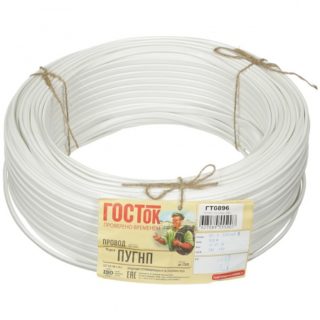
Electric cable is a kind of PUNP with flexible conductors. It is cheaper in comparison with NYM or VVG and until 2007 was manufactured according to TU 16.K13-020-93. The low quality of products for the organization of the power grid was the reason for the ban on production. Currently, some manufacturers produce PUNGP, so after purchasing it you need to check it:
- put in a freezer with a temperature of -15 degrees and inspect the shell for cracking;
- After holding in the freezer for about 2 hours, heat the twist for 60 minutes at room temperature and wind it on a cylinder 10 times longer.
If the cable body remains intact, it is allowed to use it for its intended purpose - for arranging internal lighting, power supply to small household appliances and industrial units.
The permissible rated AC power for the cable is 250 V.
Description and construction
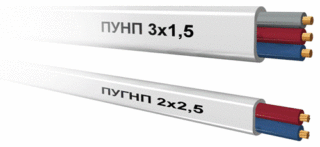
Initially, the material was developed as a conductor for connecting household appliances. Now it is produced without reference to GOST, which affects the efficiency and safety of operation. Flexible modification of PUNP cannot be classified as a wire, because it includes several cores and a general insulating cover. The product also does not fit the technical and operational criteria of the cable.
Explanation of the abbreviation:
- P - the name "wire";
- UN - universal purpose;
- Г - flexible;
- P - flat.
At the beginning of the contraction, there is no letter "A", which means that he has copper veins. Structurally, the PUNGP consists of:
- 2 or 3 conductive strands of stranded strands;
- insulating PVC sheath 0.3 mm thick for each element;
- a common insulating layer made of PVC with a thickness of 0.5 mm.
Copper with high conductive rates is used for stranding the conductors. The multi-wire technology had to provide the necessary flexibility - if one element breaks, the conductor will be able to carry current, but the load on the wiring will increase.
The parallel arrangement of the strands without twisting makes the wire flat. It is problematic to provide an accurate description of the material, since manufacturers use plastic compounds with different fire resistance.
PUNGP has no aluminum analogues due to the small cross-section of the conductors.
Varieties of wire
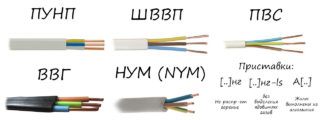
Manufacturers release several modifications:
- PUNGP-ng - with insulating non-combustible coating;
- PUNGP ng - LS - with insulation that is not subject to fire and smoldering;
- PBPPG - decoding indicates industrial and domestic purposes.
All types are distinguished by the parallel laying of the cores.
Installation and operating conditions
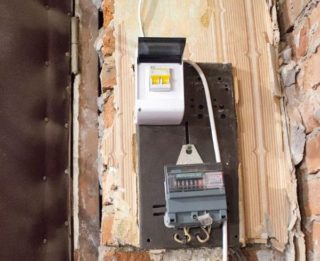
Flexible stranded wire PUNGP modification is used for alternating current power grids. When using the product, the following conditions are observed:
- use only for alternating current with voltage up to 250 V and frequency up to 50 Hz;
- operating temperature - from -50 to +70 degrees;
- the air temperature at the time of laying is not lower than -15 degrees;
- maximum heating temperature of working elements - +70 degrees;
- air humidity - 100%;
- warming up the environment - +35 degrees;
- permissible bending - radius of laying of at least 10 cable diameters.
The insulating properties of a conductor 1 km in length at a temperature of +20 degrees are determined by its total cross-section:
- 1 mm2 - up to 27.1 Ohm / km;
- 1.5 mm2 - up to 12.1 Ohm / km;
- 2.5 mm2 - up to 7.41 Ohm / km;
- 4 mm2 - 4.61 Ohm / km.
The overall diameter of the product and the diameter of the cores are checked with a vernier caliper.
Installation features
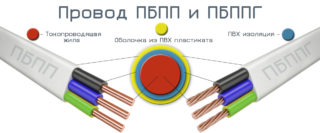
Since PUGNP is a fire hazardous material, it is necessary:
- Make a cut and determine the color of the veins.
- Using a magnifying glass, establish the uniformity of the wire.
- Equip the circuit with an automatic switch for protection.
- Divide the wiring into several groups.
It is better to purchase the wire with a margin - this increases the safety of the electrical main.
Application area
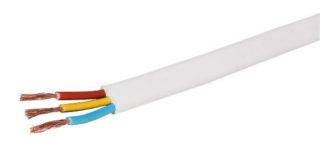
The PUNGP wire should be selected in accordance with the line protection level, installation diagram, network load. The material is most often purchased for the following purposes:
- Lighting. The conductor is connected to equipment, current sources. He is pulled from the switchboard to the lamp through a switch. The cores can overheat if the mains voltage is more than 250 V;
- Wiring fittings for lamps and chandeliers. Inside the lighting fixtures, modifications with 1-2 cores with a cross section of 1.5 mm2 are used. They distribute current to medium-power and low-power consumers of an apartment or house;
- Temporary electric highway. Laying is done for the purpose of a temporary line for the period of repair. Then it is replaced with a safe cable.
When calculating the current load, take into account the maximum cross-section of the PUNGP conductor - less than 6 mm2.
Technical characteristics of PUNGP wire
The main characteristics that a technical and household conductor have are presented in the table.
| Primary appointment | Lighting and power supply of low-power equipment |
| Laying type | Fixed |
| Line voltage limit | 250 V |
| Core material | copper |
| Number of cores | 2-3 |
| Insulation material | PVC compound |
| Allowable temperature | + 50 ... -50 - working with preservation of properties |
| +70 - long-term safety factor | |
| +80 - maximum short-term heating | |
| +15 - installation allowed | |
| -15 - permissible minimum value for styling | |
| Elasticity | Bending radius - from 10 conductor diameters outside |
| Air humidity in the warm season | 100 % |
| Insulation type | PVC double deck |
| Winding color | Black / white with blue / red marker |
| Basis type | Solid wires without twisting |
| Hard | |
| Popular cross-sections of veins | 1.5 and 2.5 mm2 |
| Packing weight (cross-section) | 2x1.5 - 50 kg / km |
| 2x2.5 - 70 kg / km | |
| 2x4 - 110 kg / km | |
| 3x1.5 - 70 kg / km | |
| 3x2.5 - 100 kg / km | |
| 3x4 - 150 kg / km | |
| Cross-section range | Two-core - from 0.35 to 6 mm2 |
| Three-core - from 0.35 to 4 mm2 | |
| Lifetime | 15 years |
Some manufacturers indicate a 2-year warranty period.
Alphanumeric marking
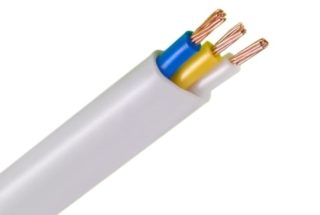
It is possible to decipher the PUNGP 3x2.5 marking as a universal flexible flat wire with three cores with a cross-sectional area of each 2.5 mm2. The actual characteristic of the section is 30% less than the nominal. This is due to the lack of a single production standard.
Another point in decoding the PUNGP wire is the presence of the letter "G". Copper, unlike aluminum, is not a flexible material. There is a possibility that an inaccuracy was made during the registration of the mark.
Weight and dimensions
A unified table is used to determine the weight and parameters of the cable.
| Section parameters | Transport outer diameter, mm | Packing and transportation weight, kg / km |
| 3x4 | 4.8x11.8 | 150 |
| 3x2.5 | 4.2x10 | 100 |
| 3x1.5 | 3.8x8.8 | 70 |
| 2x4 | 4.8x8.5 | 110 |
| 2x2.5 | 4.2x7.5 | 70 |
| 2x1.5 | 3.8x6.5 | 50 |
Load currents of wire PUNGP
After installation, the network must withstand an alternating voltage of 1500 V at a frequency of 50 Hz for 60 seconds. At the same time, there are no permissible load currents in the specification. PUE regulate the use of the data in the table for any method of installation of the PUNGP.
| Section parameters | Wire load current by number of cores | |
| 2 cores | 3 cores | |
| 1,5 | 19 | 19 |
| 2,5 | 27 | 25 |
| 4 | 38 | 35 |
Reasons for the ban on use
The use of PUNGP is prohibited, since the Russian GOST does not regulate the release of these products. In TU 16.K13-020-93 with the characteristics of the cable, there is a moment that allows a run-up over the cross-sectional area up to 30%. Manufacturers do just that in order to reduce the selling cost. As a result, after purchasing a material with a nominal cross-section of 2.5 mm2, it turns out that the cross-section does not even reach 2 mm2. Experienced electricians check the cable with a vernier caliper, but DIYers install it in a network, the load of which will be critical for a thin cord.
The thickness of the PUNGP insulating layer does not fit modern standard electrical conductors. They are produced with a shell with a thickness of 0.4 to 0.5 mm, the TU indicates a different figure - 0.3 mm.
According to unofficial statistics, in 50% of cases, the wiring made from the PUNGP cable lights up.
Users purchase cable products PUNGP due to their inexpensive cost, not focusing on fire safety and non-compliance of a number of characteristics with normative ones. To prevent a fire in the wiring, it is worth laying the cable only indoors in a pipe or corrugation. The parameters of the cores should be measured in the store, paying attention to the color marking of the cores, the thickness of the outer sheath.








